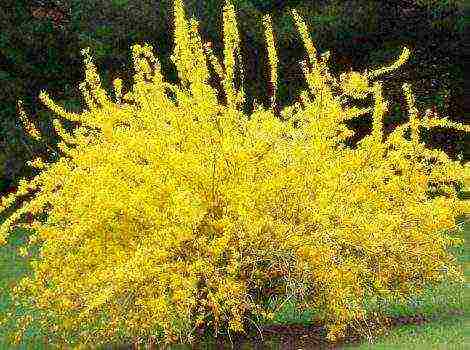Content
- 1 Meet the pumpkin!
- 2 How to grow a pumpkin from seeds
- 3 Soils suitable for growing pumpkin
- 4 Pumpkin predecessors
- 5 Pumpkin care
- 6 Preparing for planting pumpkin in open ground
- 7 Landing technique
- 8 Pumpkin care
- 9 Pumpkin pests or diseases
- 10 Collecting and storing pumpkin
- 11 Types and varieties of pumpkin
- 12 Outdoor pumpkin varieties
- 13 Pumpkin - features of cultivation
- 14 Landing in open ground
- 15 Pumpkin - outdoor care
- 16 Diseases and pests of pumpkin
- 17 Harvesting and storage
In central Russia and in other territories with a similar climate, pumpkin varieties grow: large-fruited and hard-bore. In the southern regions, butternut squash grows. Sometimes gourd is found. Growing pumpkin outdoors is not as difficult as inexperienced gardeners imagine it to be.
Growing pumpkin outdoors
Meet the pumpkin!
Pumpkin is a well-known annual plant with a powerful root system, wide leaves, and long sturdy stems. The taproot can penetrate three meters deep into the soil, and the lateral roots spread over an area of up to four meters, in search of moisture and nutrition.
The stem of the plant "crawls away" from the base by more than seven meters. The pumpkin has large flowers of yellow or yellow-orange color, which are located alone (the plant is dioecious). On the main stem, from the tenth leaf onwards, fruits are formed.
Pumpkin Russian woman
Table pumpkin Sweetie
Hokkaido pumpkin
Almond pumpkin
Pumpkin varieties and their features
|
Hardcore |
This pumpkin is fast-growing and has a high yield. It has coarser fiber than the pulp of a large-fruited variety, and it does not last very long (up to four months) without changing the taste and nutritional characteristics. |
|
Large-fruited |
This pumpkin is a real giantess, record-holding fruits reach 60 kg. The yield is also high. And the shelf life of the fetus is up to nine months. |
|
Nutmeg |
This pumpkin can lie absolutely unchanged in a cellar or other cool and dry place for up to two years. Late-ripening variety. |
What the pumpkin loves
Pumpkin loves warmth, does not tolerate cold combined with dampness.
The place to grow the pumpkin must be sunny.
Important! The temperature that pumpkin seeds need for germination is up to + 30 ° C. At lower temperatures, they will germinate for a very long time and slowly. And at less than + 10 ° С they will not rise at all.
The entire growing season for pumpkin takes place at an optimal temperature of + 25 ° C. In this case, it builds up a rich orange pulp, fragrant, dense but juicy, and a wide leaf apparatus (up to 40 m² per plant).
Pumpkin in the garden
The pumpkin loves moisture, without a sufficient amount of which the largest fruits are not formed. If at the beginning of flowering the pumpkin suffers a drought, the flowers may fall off, and the ovary will not form.
Pumpkin is a light-loving culture. It must be grown in sunny and calm areas (ideally melon).
Melon
How to grow a pumpkin from seeds
The easiest way to grow pumpkins is to use the traditional seed sowing method. Only the seeds for sowing must be prepared.
Choosing pumpkin seeds
It all starts with the selection of seed materials. Only the largest seeds of selected quality should be taken for sowing. Thin, frail, dryish, not full should be discarded. The calibrated seeds begin to prepare for sowing.
We take only the best seeds
Seed preparation
The best way to prepare pumpkin seeds for sowing is to germinate them. This process continues until the seeds hatch. For germination, pumpkin seeds are immersed in water with a stable temperature of + 40 ° C (permissible up to + 50 ° C, it is impossible below forty). In this state, the seeds should spend at least three hours.
How to germinate pumpkin seeds
Advice! How do you get that temperature? put a bowl with germinated seeds on a radiator or other heating device, place in a yogurt maker or multicooker in the "Yogurt" mode.
Then the swollen seeds are wrapped in a well-moistened cotton cloth and left at the temperature of the living room until they are pecked. The fabric needs to be checked and re-moistened all the time to keep the seeds from drying out.
Since pumpkin is a heat-loving plant, it is recommended, especially in the middle climatic zone, to increase the cold resistance of the seeds before sowing. To do this, after pecking, they must continue to be kept in a damp cloth, but already in the lower drawer of the refrigerator, for three to five days.
Due to the heat-loving nature, it is not worth sowing seeds in open ground, first it is better to grow pumpkin seedlings.
Growing pumpkin seedlings
Seedlings are needed in order to get a bountiful and early harvest. And also so that the seeds that have hatched do not die from the cold, if the sowing is carried out at a time when cold snaps are still possible. Seedlings do not have to be grown at home - you can do this in a special nursery or mini-greenhouse. But best of all, "under supervision", to grow pumpkin seedlings on the southern windowsill of the apartment. At room temperature, which is nevertheless closer to the expected pumpkin + 30 ° C than the temperature in a spring greenhouse, the process will go faster and better.
Important! Despite the powerful and sturdy appearance, pumpkin seedlings do not tolerate transplanting well. Therefore, it is better to grow seedlings in peat pots.
To grow seedlings, you will need peat-peat or ordinary pots with a size of at least 10x10 cm in an amount half as much as the number of seeds. There is no need to try to grow a "pumpkin forest", remember about the 40 m² food area that the pumpkin can cover. Two plants, with a sufficiently spacious arrangement, a large amount of heat, light and moisture, with regular feeding, will give a larger yield of fruits in terms of number and size than ten located in the same space.
Planting pumpkin seedlings
Important! Pumpkin seedlings should be at home or in a greenhouse before planting in the ground for at least three weeks. Therefore, seeds are sown based on this calendar indicator.
Seedling soil
Pumpkin seeds are sown in normal fertile seedling soil, consisting of peat and sand. No special additives are required. Fertilizers do not need to be applied to the soil either. If growing seeds in peat pots, simply fill them with soil. If grown in plastic containers, add 3 cm of sawdust to the bottom.
Sowing seeds
Sprouted in the above way and hardened seeds are sown in pots in pairs. Later, the weak seedling can be removed by simply pinching off the stem. Sowing depth - 2 cm. Seeds are covered with peat. Watering is carried out before and after sowing.
During the first three days after sowing, the temperature should be + 25 ° C ... + 30 ° C.
Seedling care
Seedlings of pumpkin seedlings
Seedlings should appear on the fourth day.After that, the temperature must be lowered and maintained within + 18 ° C ... + 25 ° C for a week, then reduced again to + 15 ° C ... + 18 ° C. This is necessary so that the pumpkin seedlings do not stretch out, grow strong and squat ...
Pumpkin seedlings
Watering the seedlings is carried out regularly, but it should not be excessive. Stagnant water is prohibited. Ideal soil moisture and air humidity will contribute to the formation of hardy and abundantly fruiting pumpkin plants in the future.
Water your pumpkin shoots regularly
Two weeks after germination, top dressing is carried out. To do this, the mullein must be diluted in a ratio of 1:10 with water and poured into each pot, or under each plant in the greenhouse, 100 ml of nutrient solution after watering. If there is no mullein, feeding is carried out with nitrophos according to the instructions.
Video - Growing pumpkin seedlings
Readiness and disembarkation
A properly grown seedling looks like this:
- low stem, thick and strong;
- short internodes;
- three well-developed true leaves with a rich green color.
In this state, pumpkin seedlings can be planted in open ground under a temporary film shelter on the 22nd day after sowing with germinated seeds in pots.
Planting seedlings
Before planting, the holes are watered with hot water. If the seedlings are in a peat-baked container, they do not need to be removed, just slightly destroy the walls and bottom of the pot.
After planting, the plants are watered with warm water and protected with a film cover until stable warm weather sets in.
Growing pumpkin in a greenhouse
Soils suitable for growing pumpkin
This plant is most suitable for fertile soil, which has a fairly loose structure, well warmed up. It is on such land that the fruits of the pumpkin will reach record sizes.
Important! Pumpkin will grow worst of all on moist and clayey soil. Acidic soils are not categorically suitable for the plant - they must be treated with lime (liming under the predecessor) or add wood ash.
When growing pumpkins in a summer cottage, try to comply with the following requirements.
- Disembarkation from the south side of the house along a wall or fence. The building and the fence will protect from the wind during the day and give the plants the heat accumulated during the day at night.
- Pumpkin whips may well be directed at a house wall, fence, barn roof. Closer to the sun, the fruits will ripen better.
- If there is a compost heap on the south side, it is ideal to plant the pumpkin next to it, directing the whips there.
Growing pumpkin on a compost heap
Soil preparation
To successfully grow a pumpkin, in the fall, having removed the predecessors, it is necessary to start preparing the soil.
- Apply organic and mineral fertilizing to a clean, free from plants and weeds area (5 kg of humus, 15 g of potassium chloride and twice as much superphosphate per m²). If there is no humus, manure can be applied in the fall - 7 kg per m².
- Dig the area 20 cm deep.
- To lighten the soil structure, if necessary, add river sand (coarse grain) and peat.
- Deacidify the soil with wood ash.
- Loosen, stir if possible, pour over with hot water.
In the spring, there is no need to dig up the upper soil layer, it is enough to remove the weeds that have appeared and level the area with a rake. In this state, the soil should be from March to May - the time for planting pumpkin seedlings.
Prepare the soil for pumpkin planting
Two days before planting the grown seedlings, the soil on the garden bed must be dug up to 12 cm (half a shovel bayonet), ammonium nitrate must be added - 20 g per m² and holes must be made.
On light-textured soil, the holes can be shallow - up to 25 cm. If the soil is heavy, the depth of the hole should reach 40 cm. A little compost and a layer of dry leaves are placed on the bottom.
The scheme of the formation of beds for planting pumpkin
The distance between plants in a regular garden is about a meter. If possible, it can be doubled.
Pumpkin predecessors
This question is relevant because the culture is demanding of its predecessors.
| Potatoes, cabbage, onions, legumes, root vegetables. | Cucumbers and zucchini, squash, as well as melons and watermelons. |
Pumpkin care
The pumpkin does not need anxious and specialized care, but there are some activities that should not be neglected if you want to get a large harvest of large fruits.
Pumpkin, flower
Watering
The main care measure is the adjustment of irrigation. The pumpkin, like a pump, pumps out all the moisture from the ground, and then evaporates it through the leaves. Thus, the roots and stems get a little. Therefore, the moisture level in the soil must be constantly replenished.
Advice! It is especially necessary to water the pumpkin abundantly when it begins to bloom and fruit. The water temperature should not be lower than + 20 ° С (warmed up in the sun). In no case should you water the pumpkin with cold water in the heat - the plants may die.
After watering, every other time you need to loosen the soil near the base of the stem. Weed as it grows.
If the summer turned out to be dry, then before flowering the pumpkin can be watered more often.
Top dressing
You need to feed the pumpkin often, otherwise you will not be able to get large fruits. The first top dressing in the open field is after the formation of the fifth leaf. The second is when the whips begin to form. Then - every two weeks.
You can feed it with nitrophos, starting from 10 g per plant and increasing the dose by 5 g with each feeding. You can add dry granules or prepare a solution.
During the fruiting period, a glass of ash is added to each top dressing.
You can feed the pumpkin throughout the growing season with mullein solution.
How to shape a pumpkin
How to shape a pumpkin
The plant is formed in one stem, in extreme cases, in two - this contributes to high yields. To do this, after the appearance of extra shoots from the sides, they are all removed, and extra ovaries are also plucked out, leaving no more than three on each lash.
By the way! On the shoots of the second order, the pumpkin can bear fruit after the second leaf, but they will grow small and tasteless, so it is worthwhile to pinch the shoots of the plant.
Video - Pumpkin: growing and pinching
Powder
Another agrotechnical technique that contributes to yield is the powdering of the lashes. As soon as the lashes have reached a meter length, they must be carefully untangled, laid in a given direction and sprinkled with earth in two or three places. This is done so that the wind does not break the whips and leaves, breaking the ovary. But the main thing is that in internodes pressed to the ground, additional roots are formed, which will nourish the plants and contribute to the increase in fruit.
Garden care
A few more tricks
- Scourges that have climbed onto a fence or roof must be controlled. When pumpkins begin to ripen on them, secure them by placing them in ordinary shopping bags and securing them to additional fasteners. Otherwise, heavy fruits will slide down, breaking off the stems.
- It is undesirable, especially in wet weather, for the fruits to lie on bare ground. When they are medium sized, place planks or other breathable material underneath them.
Pumpkin pest control
Video - How to properly grow and care for a pumpkin
Harvesting pumpkin
Mother, fatty, darling, queen of the garden - this is what the people call a pumpkin.
The plant in any conditions - in the garden or in the field - behaves like a business. Planting and caring for pumpkin outdoors is not difficult. The article describes how to grow different types of this crop.
Preparing for planting pumpkin in open ground
Caring for a pumpkin is easy. If you follow the recommendations given in the article, a tasty and healthy harvest will ripen in the garden in the fall.
Landing dates
Pumpkin cultivation technology provides for ways:
- direct sowing into the ground;
- growing by seedlings.
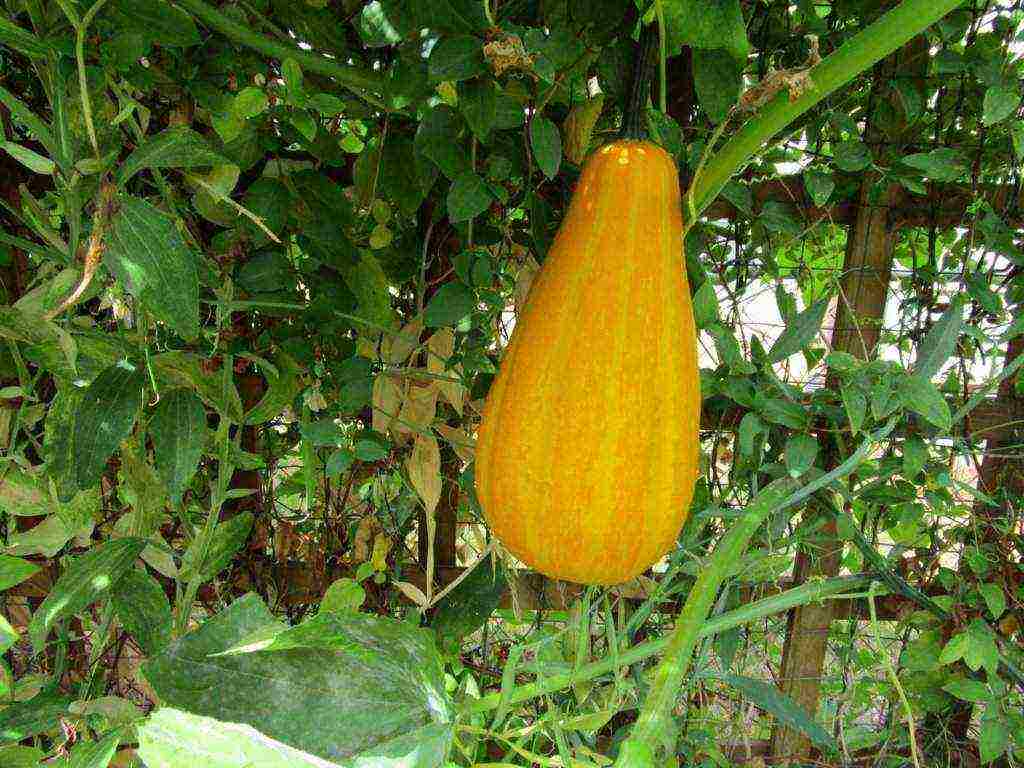
When choosing the time when to plant a seed, take into account that large, leathery-coated seeds of ordinary (hard-bore) and large-fruited species germinate at + 10-14 ° С, and the soil at a depth of 10 cm should warm up to + 10-11 ° С. The air temperature +15 ° С is the minimum for growing.
Heat-loving (nutmeg) species need a soil temperature of 12-13 ° C and + 18 ° C of air.
Seedlings will appear in 10-14 days. During this period, frosts will become disastrous - the pumpkin will not survive freezing temperatures. If the thermometer drops below +14 ° C, root growth stops, the plant does not develop well and the risk of disease increases.

In the southern regions, the landing time begins in early April, the timing changes with a shift to the north. For the middle lane, this is the period from May 20 to June 10. In Siberia and the Urals, it is better to grow the queen of the garden in the open field with seedlings.
Sowing with seeds for the preparation of planting material begins 25-35 days before the intended pick into open ground.
Choosing a place on the site
When choosing a place on the site, take into account that the pumpkin occupies a large area. In the shade of large leaves, neighbors in the garden will feel bad. Long-leaved varieties are able to "release" a shoot up to 12 m long.
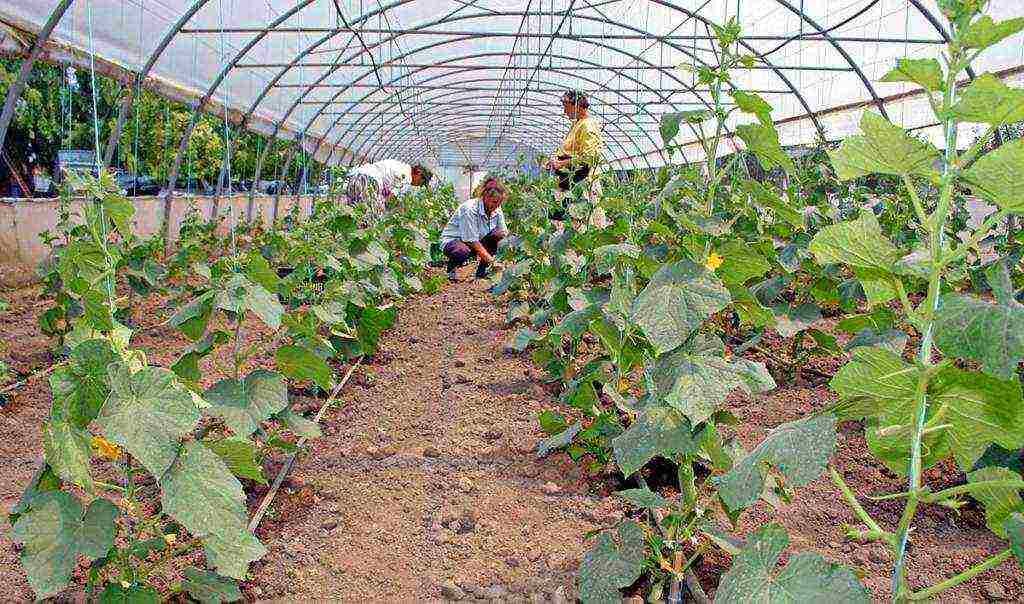
Sunny, blown by the winds - this is an ideal place in the garden, and the number of hours of sunshine directly affects the yield of plantings.
If there are no spatial restrictions in the field, then growing methods are used in the garden:
- On compost heaps, using space that is precious for the garden, but unnecessary for other plants and the heat generated by the waste organic matter;
- Along the fence. The lashes will attach themselves to the mesh fence; they are tied with a soft rope on a picket fence. Plants raised above the ground make it convenient to till the soil. After the fruits have grown, they are placed in mesh bags fixed on the fence supports - the fragile stalks will not withstand the increasing weight of the fruits.
- Vertical cultivation is suitable for small-fruited and ornamental species. Growing lashes are tied to the walls of the house, the supports of the arbors and the trunks of trees. Large fruits are placed in tied mesh bags.
- On insulated beds, the pumpkin can be planted earlier than in open ground, but to protect against frost, the plants are covered with a film or agrospan.

Soil preparation
The root system of climbing varieties takes up to 8 m², so it is necessary to prepare the entire area of the garden for planting. Before the autumn digging, two buckets of manure or humus per 1 m² are added to the soil. It is not bad to add 40-60 g of superphosphate and potassium sulfate each and a glass of wood ash per 1 m² in the fall.
Bush varieties are planted in individual holes, into which 2/3 buckets of humus are poured in autumn, 2 tbsp. l. superphosphate, 1 tbsp. l. potash fertilizer and 4-5 tbsp. l. ash.
In the spring, the garden bed or holes are dug up again to give the earth looseness.
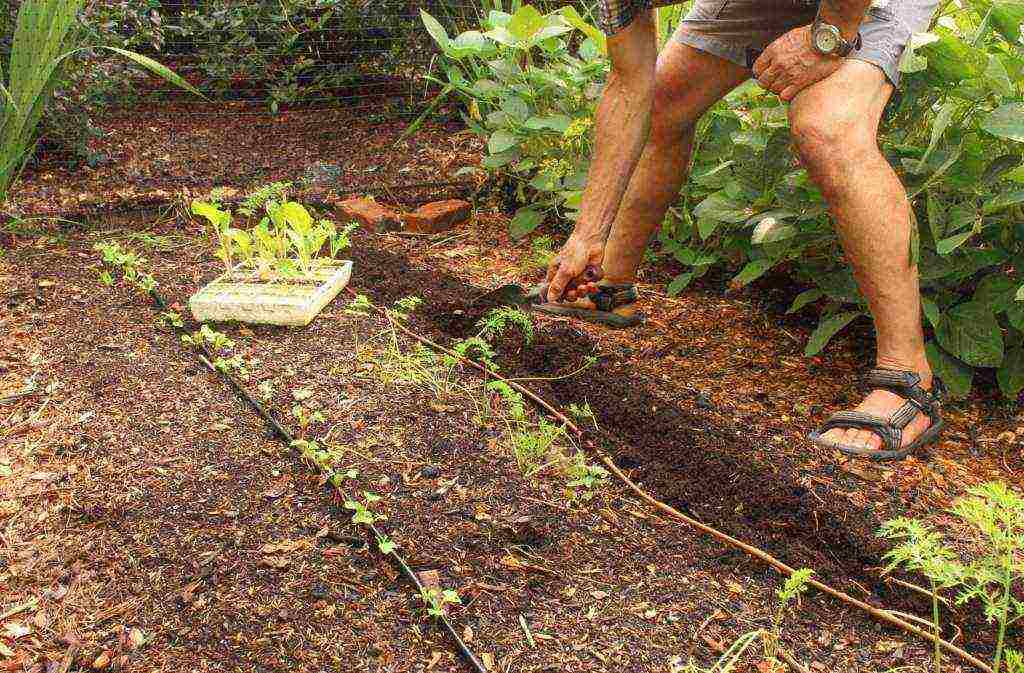
Selection and preparation of planting material
The fullest and largest seeds are selected for cultivation. The best are only two to three years old. Last year's are heated for 3 hours in a thermos filled with water at a temperature of 60 ° C. This stimulates the formation of female flowers on the future plant. The procedure can be replaced by a two-month warm-up at the central heating battery.
« Mark the name of the variety and the start time on the bag.»
Accelerate germination and increase germination by soaking in nutrient solutions and growth stimulants: "Ideal", "Gumi", "Epin". The funds are used based on the instructions of the manufacturers.

Folk councils recommend soaking in ash infusion - 1-2 tbsp. l. fall asleep in 1 liter of water and leave for a day. The processing time of the planting material is 3-5 hours. Soaking is combined with disinfection by adding potassium permanganate to the solution until a pale pink color is obtained.
« Soaking by immersion in the solution lasts no longer than 6-10 hours, otherwise the seeds will suffocate.»
Before planting, it will not be possible to soak and germinate the seeds with seeders, and when grown in the garden, such procedures will help save on planting material and accelerate the emergence of seedlings.
Germination is carried out at a temperature of + 25-30 ° C, spreading the seeds on a damp dense cloth. Gauze and nonwovens are not used - in them the roots will become entangled and damaged during planting. To preserve moisture, the container is placed in a plastic bag.

Landing technique
Pumpkin is not propagated vegetatively - it is grown only from seeds. There are two ways to land on a permanent seat:
- Direct seeding is used in the southern regions. The method is suitable for the middle lane when growing early ripening pumpkins.
- By driving out seedlings, they get a harvest in almost all regions of the country by choosing a zoned variety.
Direct seeding
Hard-bore and large-fruited pumpkins are sown to a depth of 5-8 cm.In clayey, heavy soil, the holes are made smaller - 4-5 cm.In early periods, sowing is carried out to a depth of 8-10 cm, this will increase the time until the emergence of shoots, which will save the plant from recurrent frost.

For thermophilic species of nutmeg gourd, the embedding in the ground is made 1-2 cm smaller than for large-fruited varieties.
The planting scheme is chosen based on the manufacturer's recommendations for each variety or hybrid.
Attention! «The recommended distances cannot be reduced - the pumpkin has a branched root system and a strongly growing ground part. Plants will oppress each other, block the sun's rays. A tight fit interferes with the free movement of air - this is the cause of fungal and viral diseases.»
2-3 seeds are sown in each hole in order to leave the most healthy sprout in the future.
Seedlings are thinned after the appearance of 1-2 true leaves. It is impossible to delay the procedure - the seedlings will drown out each other. When thinning, the plants are cut, not pulled out of the soil, so as not to damage the roots of the remaining sprout.
Seedling method
Seed preparation for growing seedlings is similar to processing for direct sowing. Seedlings form true leaves 15-20 days after germination. By adding 10 days for germination, we get the sowing time of the seeds.
Diving pumpkin crops are difficult to tolerate, so the seedlings are immediately grown in separate containers. Use disposable, or peat, or cups rolled from old newspapers, flower pots. Drainage holes are made in waterproof containers.
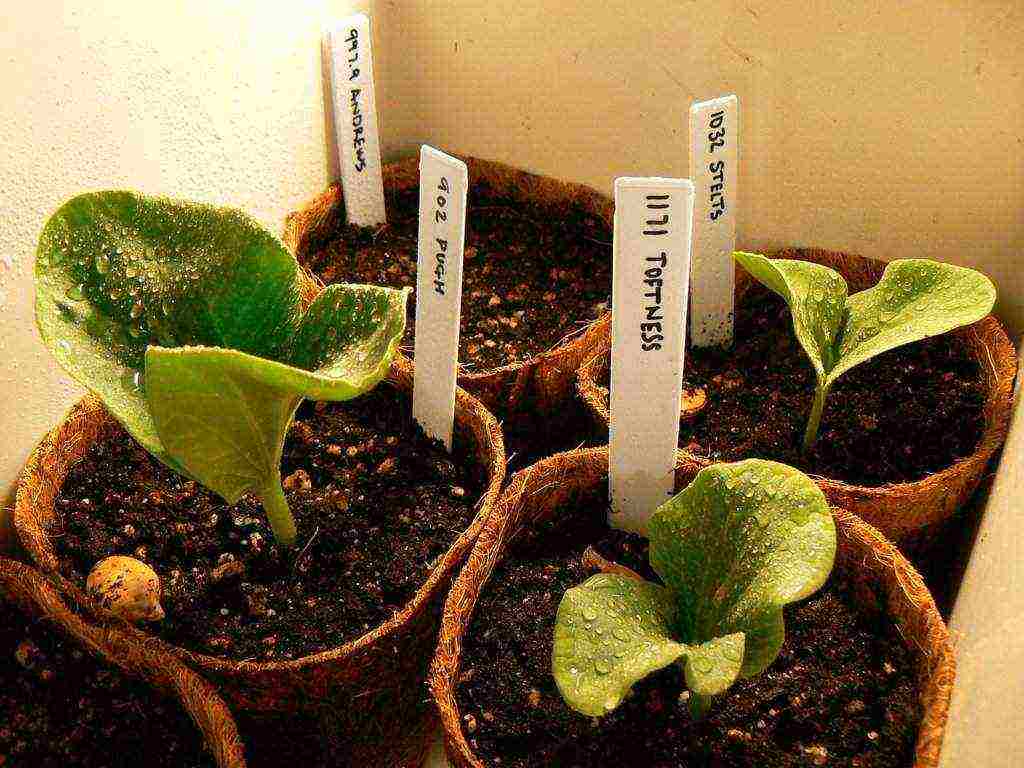
Soil composition for seedlings:
- humus - 2 parts:
- lowland (black) peat - 1 part;
- rotted (brown) sawdust - 1 part.
Add 1 tbsp to a bucket of the resulting mixture. l. complex mineral fertilizer or replace it with 1 tsp. urea, 1 tbsp. l. double superphosphate and 2 tbsp. l. wood ash.
If you are not sure of the quality of the planting material, 2-3 seeds are placed in each container, deepening them by 2-4 cm. The temperature for growing seedlings is + 18 ... 25 ° С during the day and + 15 ... 18 ° С at night.
You can do without additional fertilizing, but to obtain healthy planting material, pumpkin seedlings are fertilized twice: 8-10 days after germination and 2-3 days before planting the pumpkin in the ground.
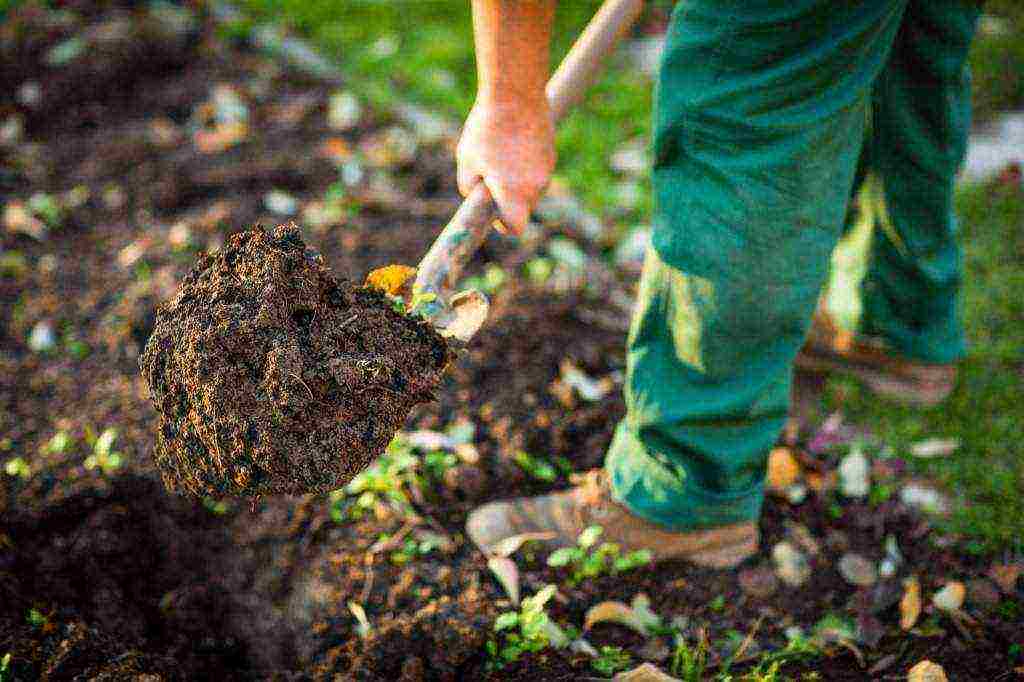
5-7 days before transplanting into the soil, the seedlings are hardened. To do this, air the greenhouse during the day, if the cultivation was carried out there, or take out the pots with sprouts to fresh air. Ready for planting seedlings should be stocky, with short internodes and two or three true leaves.
Landing in open ground begins when the threat of recurrent frost has passed. In the middle lane, this is June 10-12, if you apply film shelters - May 20-25.
Pumpkin care
Planting and caring for pumpkin outdoors includes the usual agronomic measures:
- watering;
- weeding;
- top dressing;
- thinning of seedlings;
- bush formation.
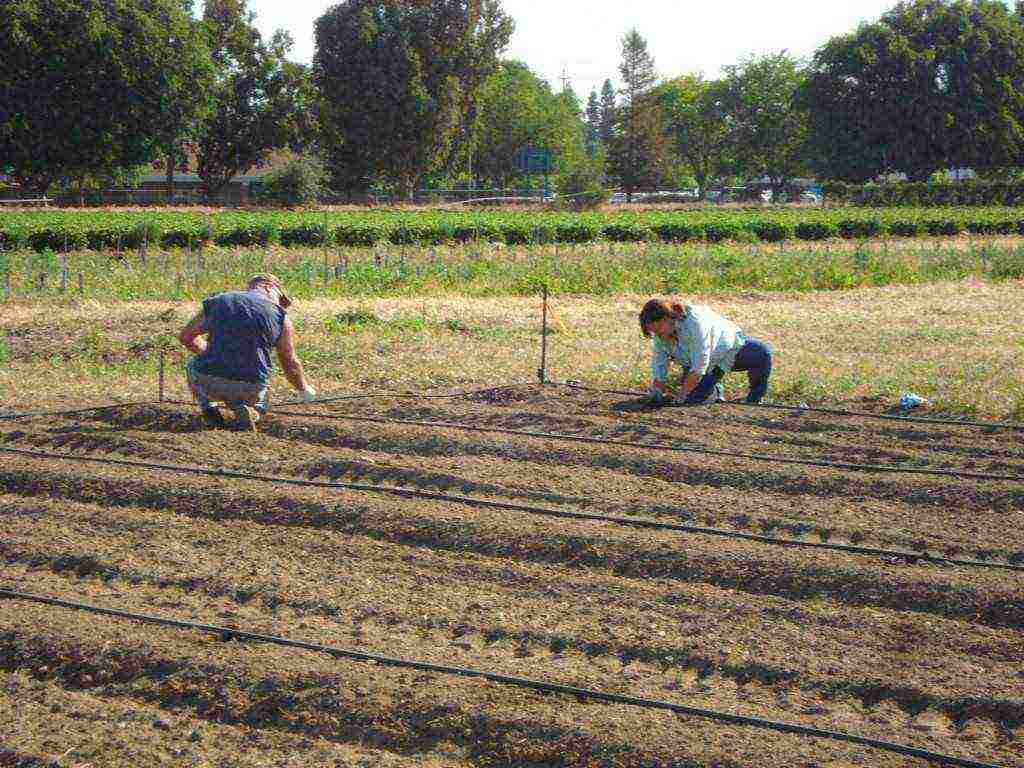
Watering the pumpkin
For the normal growth of the green mass and the gain in weight of the fruits, the pumpkin needs infrequent, but abundant watering.Each time, 1-2 buckets of water heated to ambient temperature are used for an adult plant grown in the beds. The soil should be soaked to a depth of 50 cm, where the main part of the roots lies.
Particular attention is paid to watering during the ripening period of fruits and reduced during flowering. The increased air humidity from evaporation worsens the pollination of female flowers.
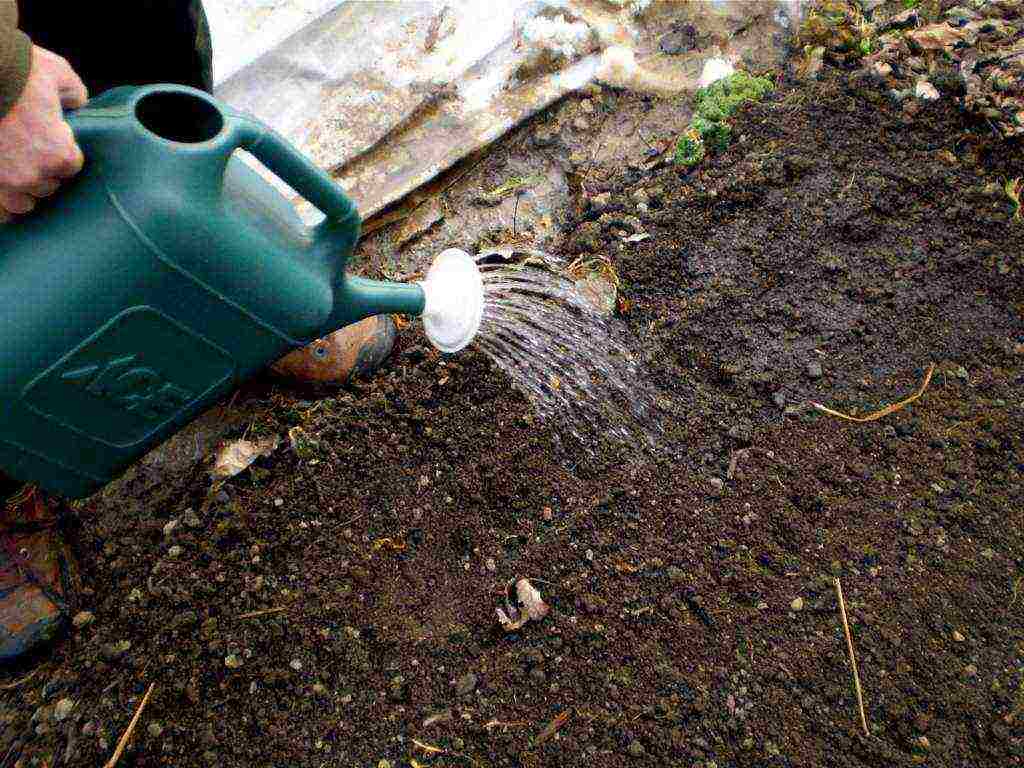
Soil loosening
Loosening of the soil is carried out regularly only until the rows close - after that mechanical treatment can damage the plant. Before emergence, the soil crust is removed, the formation of which can be prevented by mulching the planting site.
During all periods of growth, the soil is loosened to a shallow depth so as not to damage the surface roots.
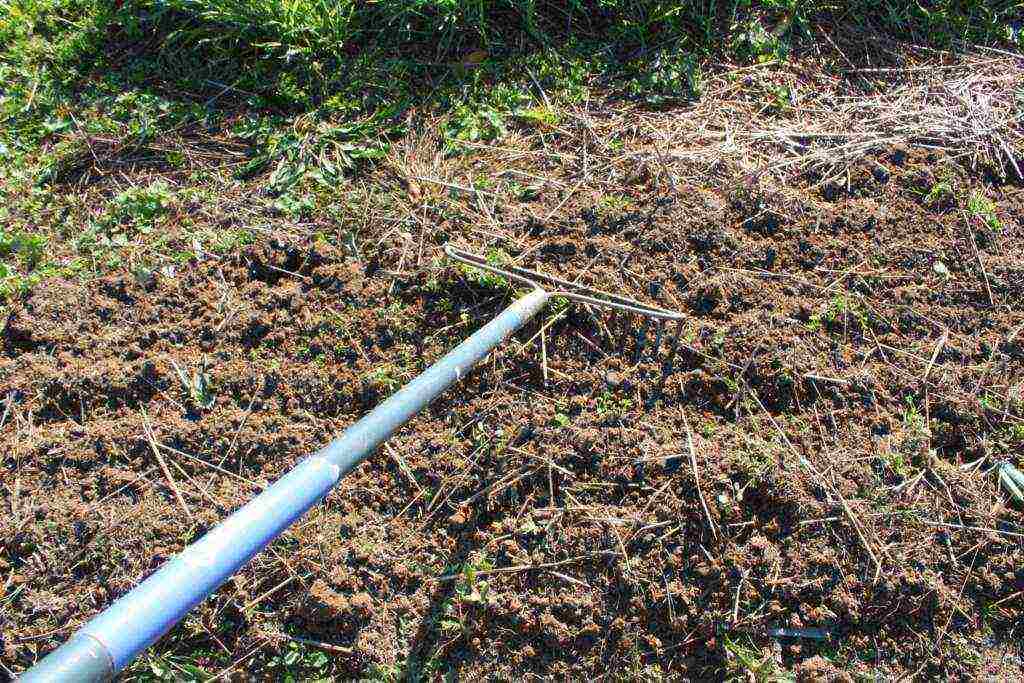
Feeding pumpkin
The pumpkin forms the largest fruit of any plant in the garden. It will not be possible to grow a record harvest without regular feeding. The first time fertilization is applied 15 days after planting the seedlings or 20 days from the emergence of seedlings.
Add mullein infused in water (1:10) or bird droppings (1:15) with the addition of 2 tbsp. l. complex mineral fertilizer. Another composition can be obtained by fermenting weeds without mature seeds. Half a barrel or any other container is filled with chopped green grass. Filling the container to the brim with water, after 3-5 days they receive a ready-made dressing. Liquid consumption: ½ bucket per square meter.
«Fertilizers are applied into a groove made at a distance of 15-20 cm from the sprout - this will protect the roots from chemical burns.»
The second feeding is carried out after fruit setting. Apply a complex or other water-soluble fertilizer according to the manufacturer's instructions.

Forming a bush and pinching the lashes
Bush varieties do not need shaping and pinching.
In climbing species, the main crop is laid on the main stem, therefore, so that the plant does not waste extra energy, the side shoots are removed immediately after emergence. You can play it safe and leave two lashes for a guaranteed ovary.
When 2 fruits with a diameter of 10 cm or more are tied on the plant, 4-5 leaves are left on the lash after the second ovary and pinching is carried out. At the same time, all the ovaries that have reappeared in August and later are removed - they will not have time to ripen before the cold weather, taking away some of the nutrients. It is necessary to pinch the lashes in the morning of a sunny day.

Pumpkin pests or diseases
The succulent, fleshy leaves and stems of the pumpkin are susceptible to disease and pest infestation. Compliance with growing rules contributes to the prevention of diseases:
- Autumn digging of the soil with the harvesting of plant residues after the previous culture.
- Compliance with crop rotation - the pumpkin is returned to its previous place no earlier than after 3-4 years.
- Removal of weeds in which pest larvae hibernate and develop.
- Sowing seeds in warm soil reduces the likelihood of disease.
- Watering with cold water delays the development of plants.
- Immediate removal of diseased plants and diseased leaves from healthy pumpkin.
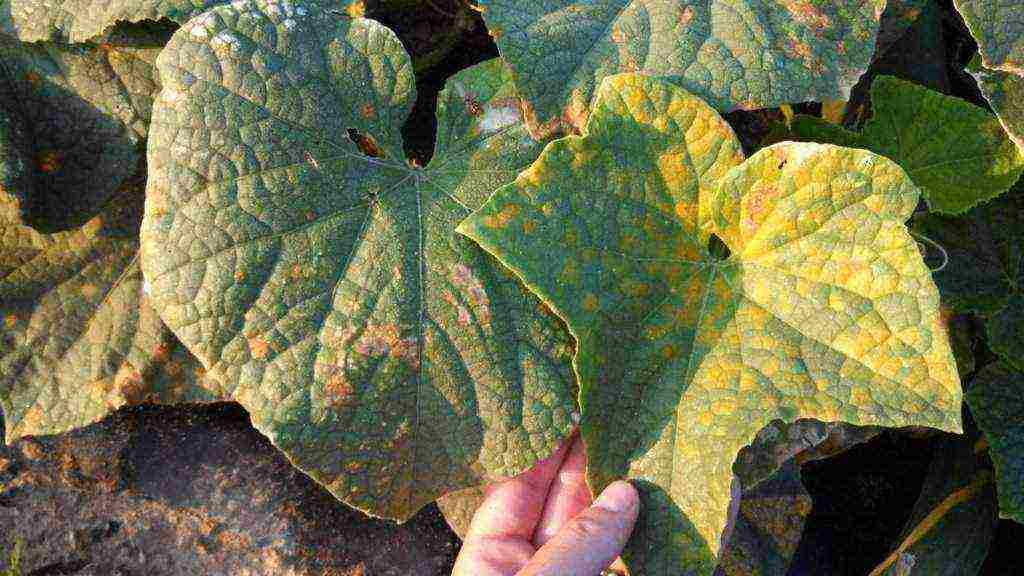
The most common and dangerous diseases:
- powdery mildew;
- downy mildew;
- white, gray and root rot.
Insect pests, in addition to sucking juices from the plant, are spreading diseases:
- The melon aphid is a piercing-sucking insect that hibernates in field weeds.
- The whitefly feeds on sap, settling on the inside of the leaves.
- Medvedka eats up underground parts of plants.
- Slugs damage young plants by feeding on pumpkin leaves.
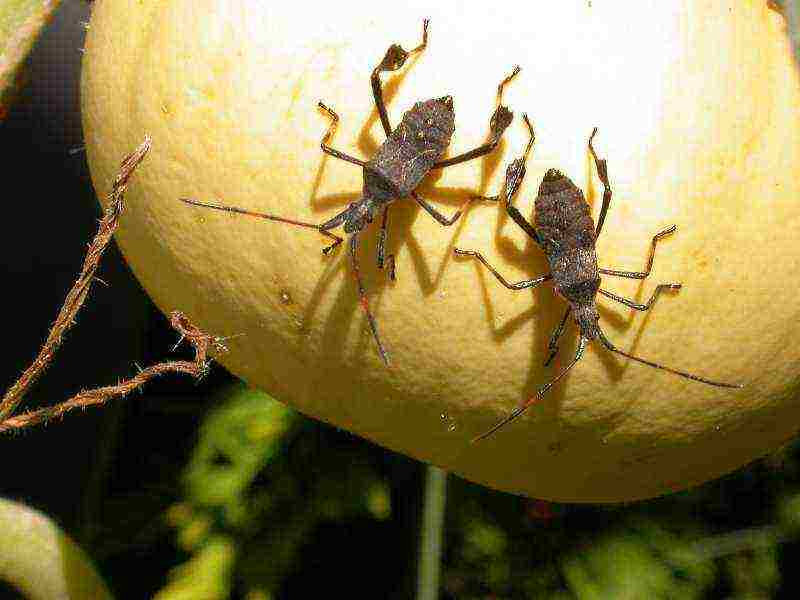
Collecting and storing pumpkin
Ripe fruits are suitable for winter storage. A crop that has not yet matured is eaten or used as feed for livestock immediately after harvest - it will not be able to be stored for a long time.
It is necessary to remove hard and large-fruited species from the garden after the stalk has dried. Collecting pumpkin of nutmeg varieties begins after the skin hardens - it does not bend when pressed.
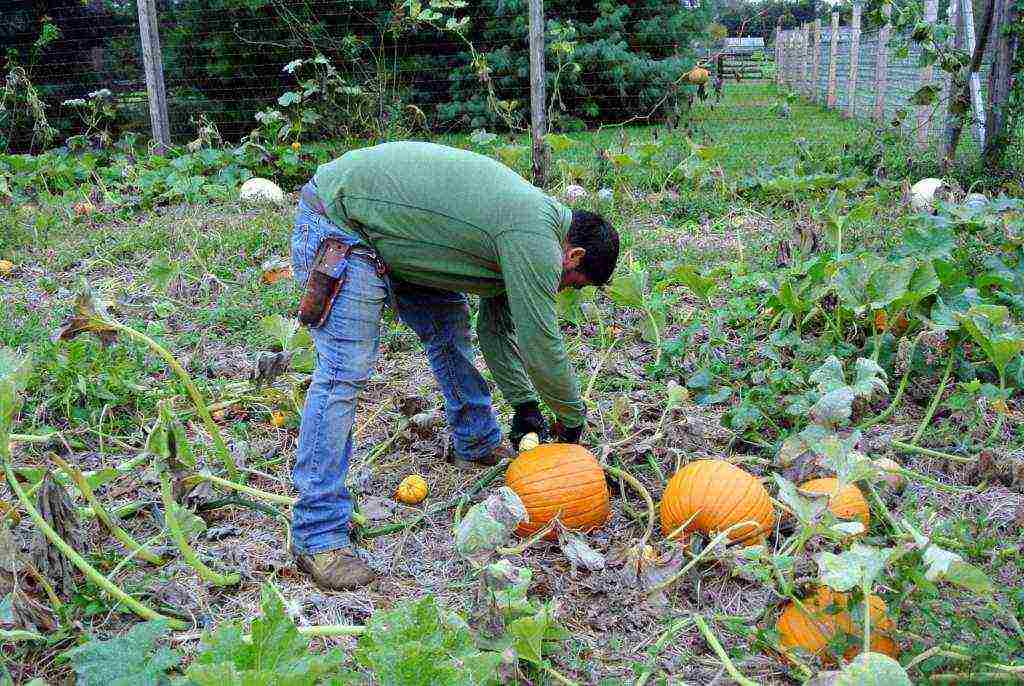
When harvesting, the fruits are carefully cut off along with the stem, the pumpkin quickly rots without it. A few words about how to store the pumpkin. The harvest is ripened in dry rooms, then kept at room temperature in the dark.
Over time, the pumpkin loses mass due to the gradual evaporation of moisture. The taste of the pulp is improved by converting the starch into sugar. Fruits that have begun to rot are immediately removed to prevent contamination of healthy ones.

Types and varieties of pumpkin
When choosing planting material, you need to know what types of pumpkin exist.
Butternut pumpkin (Cucurbita moschata)
Muscat species are the most thermophilic, and they ripen much longer than others. Plants are not very suitable for growing in the middle lane - there are rarely temperatures above +30 ° C needed for normal development.
Among the varieties stand out:
- "Vitamin". The variety is used in the pharmaceutical industry, contains up to 6% sugar and a record amount of carotene for pumpkins. Not intended for storage and can be used within a month after harvesting.
- "Spanish". The fruit is flattened, with a sugar content of up to 10%, good keeping quality.
- "Arbatskaya". Contains up to 7% sugars, can be stored well.

Large-fruited pumpkin (Cucurbita maxima)
Large-fruited varieties are suitable for growing in the south of the country and in the middle lane. Some of them reach a mass of 90 kg. However, besides the record numbers, the giant pumpkin has no other advantages - only their transportation can cause a lot of trouble.
Among the economically significant ones stand out:
- "Mushroom winter";
- “Volga gray”;
- "Marble";
- "One hundred pound";
- “Winter dining room”.
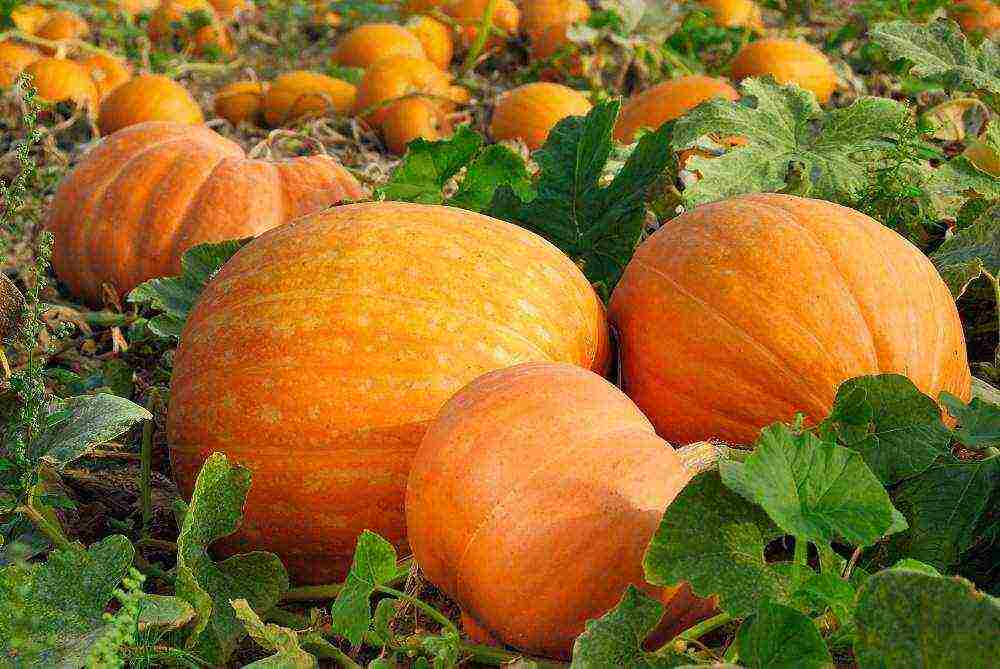
Common pumpkin, or hard-barked (Cucurbita pepo)
The hard-bore pumpkin varieties are the most cold-resistant, weakly susceptible to temperature changes.

In terms of nutritional and taste qualities, they are inferior to both nutmeg and large-fruited varieties. Most often, in personal and summer cottages, there are:
- "Altai";
- "Almond";
- "Mushroom bush";
- "Farmer";
- "Mozoleevskaya".
Having familiarized themselves with the methods of growing pumpkin and choosing the right variety, any gardener can count on a harvest of a tasty and healthy vegetable.
Pumpkin is a genus of annual plants belonging to the Pumpkin family. The root system is pivotal. Stems are well-branched, creeping, with spiny pubescence. Leaves are large, long-petiolate, five-part, with hard villi. Flowers are single, yellow-orange, unisexual. You can distinguish them by the length of the peduncle: in female flowers, it is short.
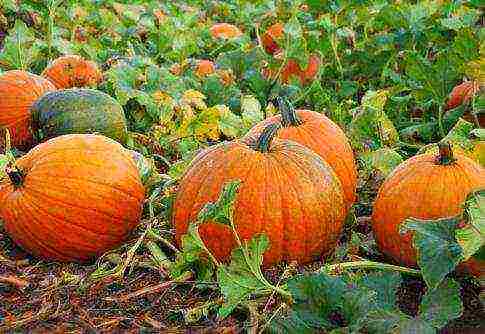 Among the many types of pumpkins, the best in quality and taste is butternut pumpkin. Its cultivation is long (up to 140 days), and high temperatures are required, which somewhat limits its mass production.
Among the many types of pumpkins, the best in quality and taste is butternut pumpkin. Its cultivation is long (up to 140 days), and high temperatures are required, which somewhat limits its mass production.
The successful cultivation of pumpkin outdoors depends on many components:
- correct soil preparation;
- high-quality seedlings;
- leaving;
- formation depending on climatic conditions.
A well-warmed and illuminated area must be taken away for planting pumpkins. The soil needs to be dug to a depth of about 30 cm and applied to 1 sq. m. up to 8 kg of decomposed compost or manure, about 20 g of potassium-containing and 30 g of phosphorus-containing fertilizers.
Pumpkin cultivation technology begins with the formation of seedlings. The seeds must be warmed up for 3 hours at a temperature of 60C, and then germinated in a damp cloth. Each seed that has hatched should be planted in a separate pot with a diameter of about 15 cm, filled with nutrient mixture. You need to germinate in room conditions, and when 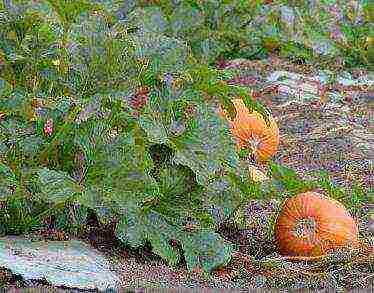 the emergence of seedlings, the temperature will need to be reduced to 140C. Seedlings should be watered sparingly, but not often. During the seedling period, two additional fertilizing with complex fertilizers will be required. Young plants are planted on a prepared bed at the end of May.
the emergence of seedlings, the temperature will need to be reduced to 140C. Seedlings should be watered sparingly, but not often. During the seedling period, two additional fertilizing with complex fertilizers will be required. Young plants are planted on a prepared bed at the end of May.
Given that the pumpkin is cross-pollinated, it makes sense to manually pollinate for a guaranteed yield.To do this, use a soft brush to gently brush over the anthers inside one flower and transfer the pollen to the stigma of another, or carefully bring the flowers closer, connecting the anthers and stigma.
This plant has a huge leaf mass, evaporating a lot of water, so growing pumpkin in the open field requires frequent and abundant watering. Even a short-term drought can greatly affect the result. During the flowering period, the amount of watering should be slightly reduced, so the fruits will be tied better. It should be fed regularly, preferably every week, starting from the 10th day after transplanting.
Growing pumpkin outdoors in cold summer conditions will require artificial acceleration of the formation and ripening of fruits. To do this, you need to limit the number of shoots, leaving a maximum of 3. After the formation of 5 ovaries, 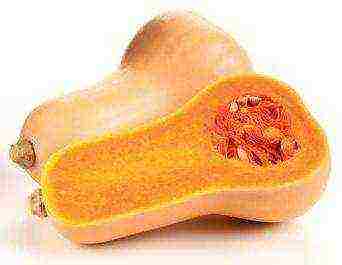 reaching 15 cm in diameter, the main stem should be pinched when the 7th leaf grows after the last fruit.
reaching 15 cm in diameter, the main stem should be pinched when the 7th leaf grows after the last fruit.
If there is a desire to grow large pumpkins, then in bush varieties you need to leave 3 ovaries, and in climbing ones - 2. It should be noted that the most delicious pumpkins are medium in size, moreover, they are easier to transfer. Shading leaves should be removed above the grown fruit to expose them to the sun.
Growing pumpkins outdoors can be carried out on trellises or fences. In this case, the fruits should be placed in bags or nets and tied to a support. If the pumpkins are on the ground, then boards should be placed under them in order to exclude the process of decay.
Harvesting the pumpkin should be done after the first freeze. You can determine maturity by pressing with your fingernail: if the bark is not pressed through, then it's time to collect. Pumpkin can be praised for its usefulness, so it is worth growing.
Well, what a vegetable garden without a pumpkin! Heavy-sided multi-colored beauties peek out from under the powerful leaves, promising delicious porridge and healing juice throughout the long winter. Growing and caring for pumpkin in the open field is up to any gardener, and its fruits will bring a lot of benefits.
Outdoor pumpkin varieties
Most often, hardy, large-fruited and nutmeg pumpkins are grown in the gardens.
Hard Bark Pumpkin.
It does not give large fruits, but it ripens quickly and has the most delicious seeds.

Varieties:
- Gribovskaya bush. It ripens early, grows up to 5 kg, the fruits are light orange with black stripes.
- Freckle. An early ripe variety with medium-sized, up to 3 kg fruits of light green color, covered with a light yellow mesh pattern. A distinctive feature of the variety is its spotted leaves.
- Almond. It grows up to 5 kg, the color of the bark is brown-orange with clearly visible green stripes. The variety ripens in medium terms and is good for storage.
Large-fruited pumpkin.
From the name it is clear that her fruits are not small. They store a lot of sugars, are easy to grow and are unpretentious.

Varieties:
- Titanium. Perhaps the largest-fruited in the world. In theory, it can give the gardener fruits up to 500 kg! In practice, such pumpkins grow only among record lovers. The variety is very tasty, the fruits are well stored.
- Therapeutic. Early ripe variety. Fruits of gray color with a barely noticeable lighter mesh have a rounded-flattened shape and a weight of 5 kg. They are distinguished by long-term storage.
- Graceful. The fruits have an unusual turban shape and pronounced segmentation. Their weight is up to 5 kg, the taste is good, and the yield is high.
Pumpkin is nutmeg.
It differs from its relatives in an elongated, often pear-shaped, later ripening period, addiction to warmth and excellent keeping quality.
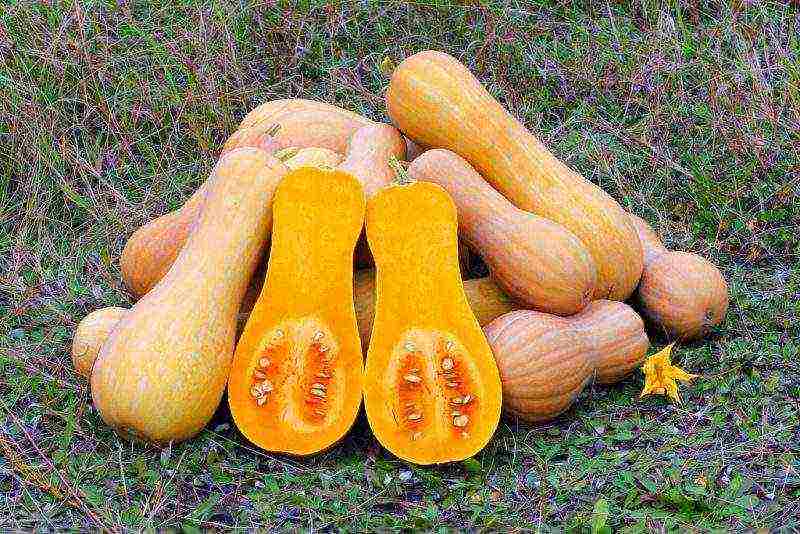
Varieties:
- Honey princess. When sown in April, it ripens in August. Produces fruits weighing up to 4 kg orange, tasty and sweet.
- Vitamin. It has an elongated shape, dark green color with lighter spots and noticeable ribbing. Fruits weighing up to 6.5 kg contain a lot of carotene.
- Muscat pearl.Late-ripening variety with pear-shaped fruits of light orange color with slight ribbing. The pulp is tender, sweet with a high content of carotene.
Pumpkin - features of cultivation
The pumpkin comes from warm places and, despite all the efforts of the breeders, has not lost its love for warmth.

Even its seeds may not sprout if the soil temperature is lower than 20 degrees Celsius.
According to the requirements for soil fertility, pumpkin is overtaken only by cucumbers. The soil for it must contain a large amount of moisture in order to water the huge leaf apparatus and the considerable size of the pumpkin. All set fruits of this plant ripen only in the south. In the conditions of the middle zone, and even more to the north, its growth should be limited, and the number of ovaries should be normalized.
The root system of the pumpkin is pivotal and penetrates to a great depth, which allows the plant to feed and extract moisture from the lower layers of the soil. But this does not negate regular feeding and watering. The feeding area for powerful specimens should be large, therefore the minimum distance between climbing plants is at least one meter, and between bush plants - 0.5 m.
Landing in open ground
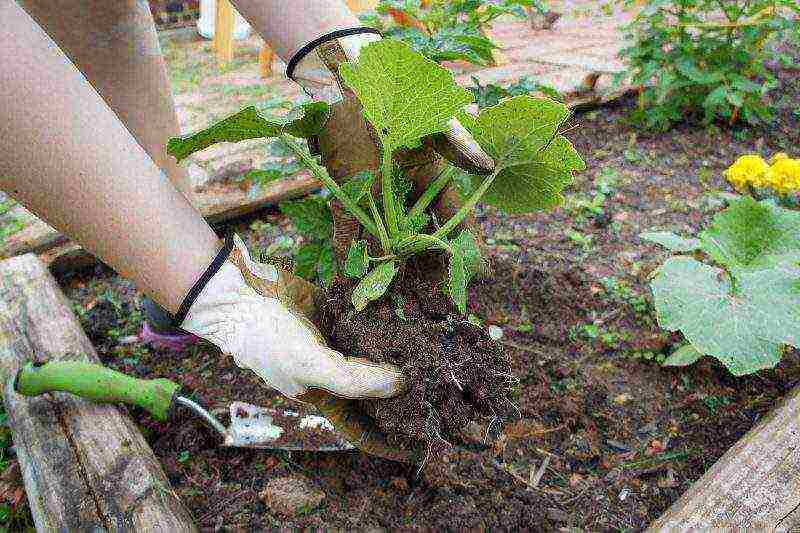
Such a huge plant is simply irrational to grow in a greenhouse. Therefore, the pumpkin is planted in open ground when the air and soil are well warmed up. Some advanced gardeners have adapted to growing a garden lady in a greenhouse, placing plants on the very edge, and directing the grown lashes to the street. So the pumpkin does not take up the precious volume of the greenhouse, but it takes full advantage of the warm greenhouse soil.
Seeds or seedlings?
The question is not idle. By sowing seeds, you can grow only early ripening varieties, and then in a warm summer. Therefore, the seedling method of growing pumpkin justifies itself with a guaranteed and high yield.
How and when to plant?
Pumpkin seedlings are not grown for a long time - strong plants quickly master the volume of any pot and begin to suffer from a lack of nutrition. The optimal age for pumpkin seedlings for planting in the ground is 30 days. If we consider that the soil by this time should have a temperature of 18 degrees, and the outside air at 20, then the relocation of seedlings to a permanent place can be planned only at the beginning of June, and later in the northern regions.
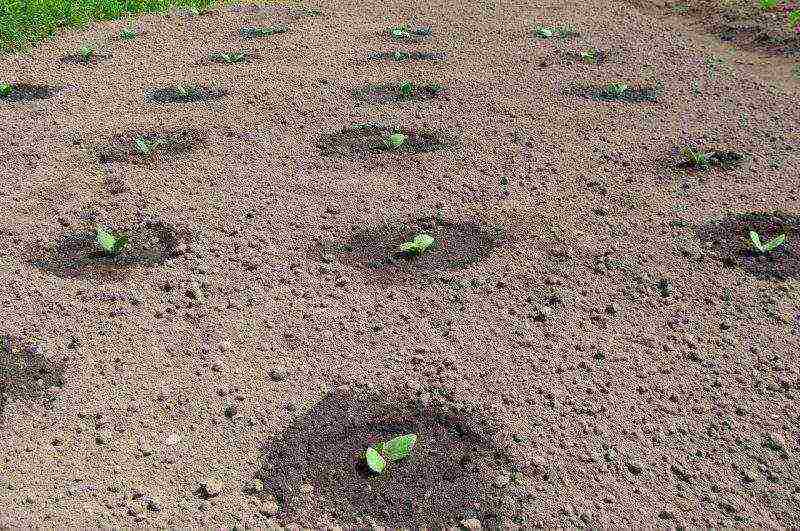
Therefore, seeds are sown in late April or early May.
As with sowing any crop, the seeds must first be prepared.
- They choose only large, fully completed seeds, rejecting all damaged and frail ones without pity. The most productive plants are obtained from seeds that have lain for 2-3 years after harvest.
- The seeds are heated in hot water with a temperature of 50 degrees. The holding time is 2 hours.
- Germinate between wet cotton pads or simply in a damp cloth until the tips of the roots appear.
- Quenched by exposure alternately on the top shelf of the refrigerator and in the room for 12 hours for 5 days.
The prepared seeds are sown in separate containers with a volume of about 1 liter.
The pumpkin does not tolerate root damage during transplantation. It is grown without diving in individual cups.
Crockery for cultivation is selected in such a way that the earthen lump is not damaged during transplantation. The soil should be loose and fertile, it should be good for air and water.
Seedlings are kept in the following conditions:
- good lighting;
- daytime temperature - 22 or 23 degrees, and night - not less than 18;
- sufficient watering, but without excess and only with warm water;
- food consisting of 2 dressings using a solution of a complete mineral fertilizer;
- obligatory hardening before disembarkation for a week.
The hardened seedlings are planted in prepared holes. To each you need to add:
- near a bucket of humus;
- a glass of ash;
- a pinch of complex mineral fertilizer;
- spill with two liters of warm water.
When planting, the seedlings are not buried.
If pumpkin is sown with seeds directly into open ground, they are prepared in the same way as for sowing seedlings. Wells are prepared in a similar way.In each, you need to place 2-3 seeds at a depth of about 5-10 cm, depending on the texture of the soil. The bed is covered with a film, which is removed after germination. In order for the soil to warm up better, it can be left by making cruciform holes for the plants. Excess shoots are pinched.
Ground requirement, site selection
Pumpkin loves to eat, so you need to choose fertile soil for it, with a high humus content.
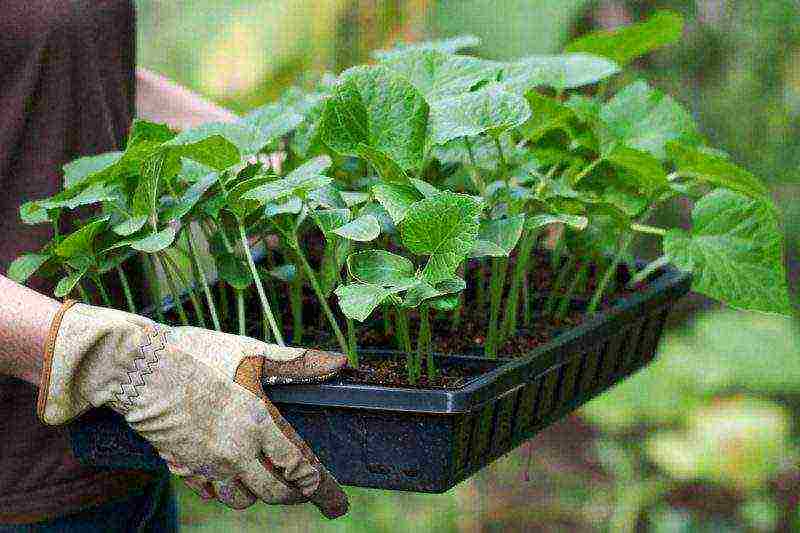
- This plant will grow well and bear fruit on a compost heap or where manure used to be.
- You can grow it in a warm garden bed. For its construction, a ditch 50 cm deep and 40 cm wide is dug. Wood waste (crushed branches and chips) is laid on the bottom, covered with grass, hay and a layer of manure. Top covered with fertile soil. The heat generated by rotting plant debris will help the plant grow faster.
- An ordinary garden bed is also suitable for growing pumpkin, which in the fall is filled with humus, manure or compost in an amount of up to 8 kg per 1 sq. m. An additional 20 g of superphosphate and 15 g of potassium sulfate are added to the same area.
Wherever you plant a pumpkin, the place should be lit all day. Even in small shade, the vigor of the plant and the yield are sharply reduced.
When choosing a place for growing pumpkin, you need to take into account the fact that it does not tolerate high standing groundwater - the roots will rot. The best predecessors for her are root crops, onions and, especially, legumes.
After any plants from the family of pumpkin or nightshade, you cannot plant a pumpkin.
The acidity of the soil is also important - ideally, its reaction should be neutral.
Pumpkin - outdoor care
In order to harvest a significant crop, all the rules of agricultural technology must be followed on time and in full.
Watering and feeding
A large area of leaves evaporates a lot of water, so regular watering is required for this plant. It is especially important for young, newly planted pumpkins.
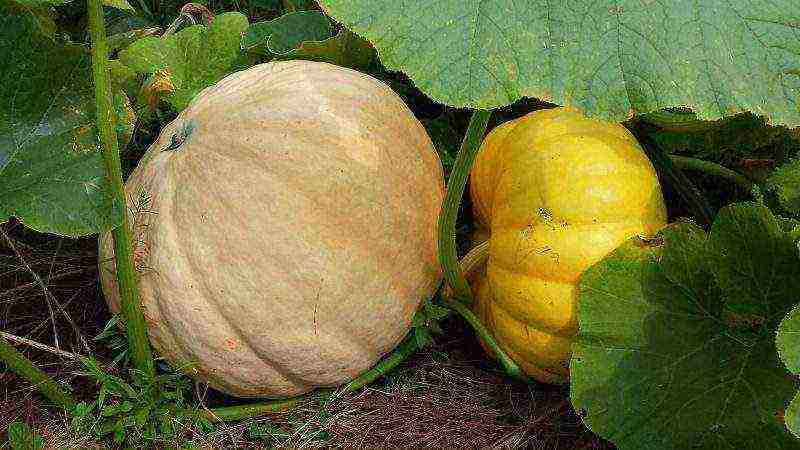
- As soon as the plants have begun, watering is stopped for a couple of weeks, unless the weather is too hot. Such a measure will help the pumpkins build up a root system.
- When female flowers and ovaries appear, watering the pumpkin should be rare, but abundant - up to 1.5 buckets per plant.
- Once the pumpkins have grown to a size appropriate for the variety, reduce watering to allow the plants to pick up enough sugars.
If the pumpkin bed was well filled with nutrients, 2-3 additional fertilizing will be enough for the plant during the growing season.
- After the appearance of the fifth leaf, the pumpkin is fed with a complete mineral fertilizer at the rate of 10 g per plant.
- With the beginning of the formation of lashes, a second feeding is carried out with the same fertilizer, but the rate is increased by 5 g per plant.
In rainy weather, top dressing is applied dry, embedding fertilizers in the soil when loosening. In the heat, they are dissolved in water and combined with fertilizing and watering. Pumpkin responds well to organic or herbal teas.
Loosening and thinning
Loosening the pumpkin is carried out the next day after watering, combining it with weeding. In the 4-leaf phase, the plants are spud to stimulate the formation of adventitious roots. Hilling is carried out only with moist soil. After the formation of lashes, internodes are sprinkled with soil.
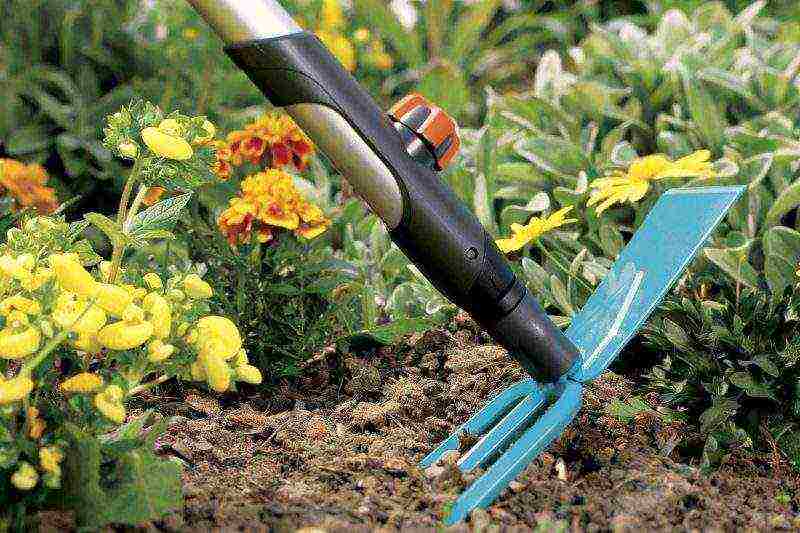
Thinning is carried out at the germination stage, leaving one of the strongest plants in the hole. The rest are plucked out.
Forming pumpkin lashes
In order for the fruits to be fully ripe, their number must be normalized. You can leave from 2 to 3 fruits on the main stem, then count 5 sheets and pinch the whip. Do not leave more than one pumpkin on the side lashes, but pinch them in the same way. All non-fruiting shoots are removed.
Diseases and pests of pumpkin
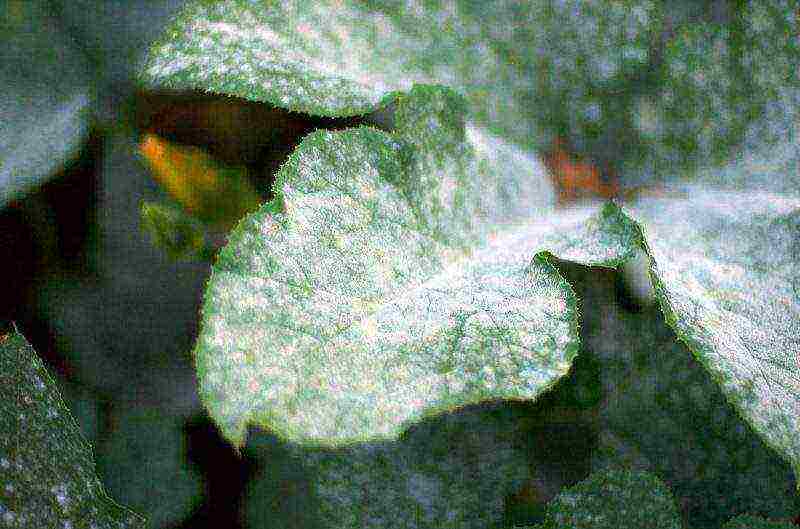
Most often, pumpkin is harmed by diseases caused by fungi:
- powdery mildew;
- anthracnose;
- white and root rot;
- bacteriosis.
They are most pronounced in damp and cold weather.Watering with cold water can also provoke a disease. Fungi live on weeds, so weeding and removing weeds from the site is a necessary event.
Copper fungicides help fight fungal diseases. In the heat, they are used when a disease occurs, and in wet weather, preventive spraying will be needed.
Yellow mosaic is a viral disease manifested by the appearance of pale spots and wrinkles on the leaves. There is no cure for this disease. At its first signs, all diseased plants are removed so that they do not infect healthy ones.
Of the pests, the pumpkin is annoyed by the spider mite, against which insectoacaricides are effective, and the melon aphid - they are fought with it with a 10% solution of karbofos.
Harvesting and storage
Only fully ripe pumpkin is stored well. Unripe fruits can also be harvested, but are best used for immediate cooking or processing.
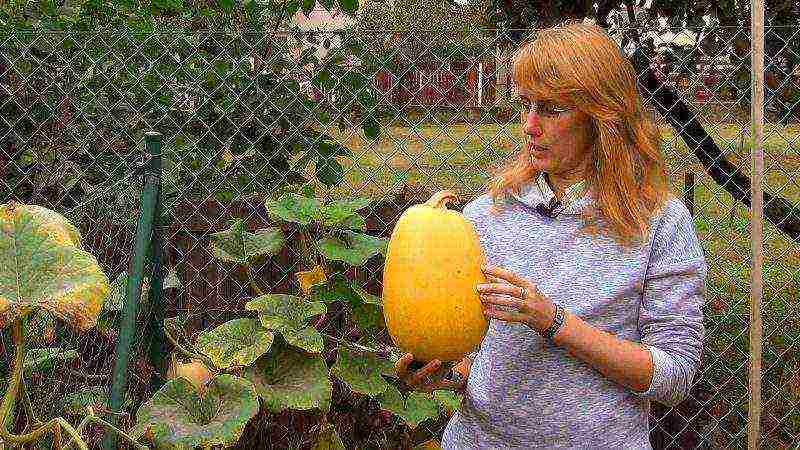
How do you know if the pumpkin is ripe?
- The foliage turned yellow and withered.
- The peduncle has become hard and woody.
- The pumpkin color is brighter and the pattern, if present, is more visible.
- When tapped, the pumpkin emits a ringing sound.
- The crust is hard and not springy.
If all the signs are there, it's time to harvest the crop. This must be done before frost, since frozen pumpkins will not be stored. Harvested without damaging the fruit.
For the first two weeks, the pumpkin goes through a ripening stage at a temperature of 14 degrees and above. In the future, the optimal conditions for storing vegetables: temperature from 3 to 8 degrees Celsius and humidity of about 70%.

